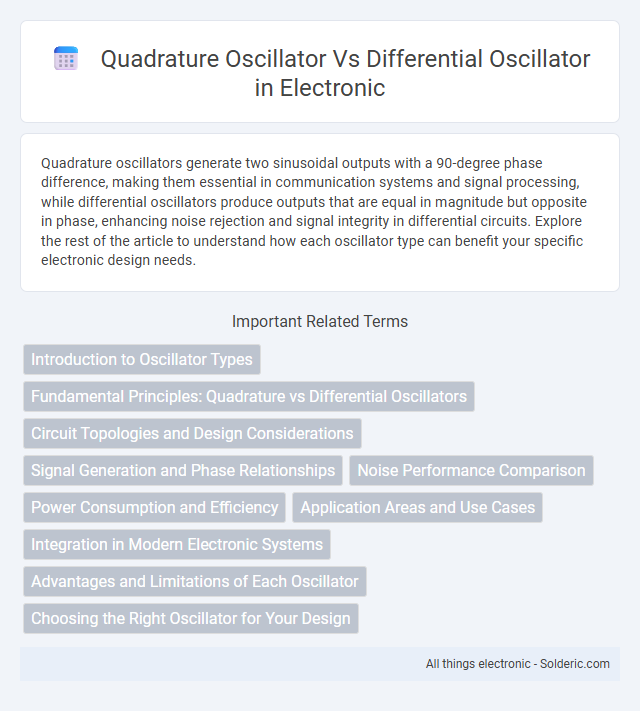Quadrature oscillators generate two sinusoidal outputs with a 90-degree phase difference, making them essential in communication systems and signal processing, while differential oscillators produce outputs that are equal in magnitude but opposite in phase, enhancing noise rejection and signal integrity in differential circuits. Explore the rest of the article to understand how each oscillator type can benefit your specific electronic design needs.
Comparison Table
| Feature | Quadrature Oscillator | Differential Oscillator |
|---|---|---|
| Output Signals | Two outputs, 90deg phase difference (quadrature) | Two outputs, equal amplitude, opposite phase |
| Operating Principle | Generates sine waves with phase shift using LC or RC networks | Uses differential pairs to produce complementary oscillations |
| Common Applications | Signal processing, communication systems, phase shifters | High-frequency signal generation, mixers, clock generation |
| Frequency Stability | Moderate, dependent on passive components | High, due to differential design reducing noise |
| Complexity | Simple circuit design with fewer active devices | More complex, requires matched transistors |
| Power Consumption | Generally low | Typically higher due to active differential pairs |
Introduction to Oscillator Types
Quadrature oscillators generate two sinusoidal outputs with a 90-degree phase difference, commonly used in signal processing and communication systems for phase-shift keying and demodulation. Differential oscillators produce output signals based on the differential input voltage, providing high common-mode rejection and improved noise immunity, making them ideal for integrated circuit applications. Both oscillator types serve distinct purposes in electronics, with quadrature oscillators emphasizing phase control and differential oscillators focusing on noise reduction and signal integrity.
Fundamental Principles: Quadrature vs Differential Oscillators
Quadrature oscillators generate two sinusoidal outputs with a 90-degree phase difference by utilizing phase-shift networks or coupled LC tanks, ensuring orthogonal signals critical for applications like communication systems and signal processing. Differential oscillators operate based on the principle of differential signal generation, where two outputs are equal in magnitude but opposite in phase, leveraging differential amplifiers and resonant elements for improved noise immunity and continuous oscillation. The fundamental distinction lies in quadrature oscillators focusing on phase-shift and orthogonality, while differential oscillators emphasize balanced differential signaling for stability and noise rejection.
Circuit Topologies and Design Considerations
Quadrature oscillators typically employ two integrator stages with a 90-degree phase shift, often using RC or LC networks to generate sine waves with precise phase quadrature, making them ideal for communication and signal processing applications. Differential oscillators utilize balanced transistor pairs or operational amplifiers configured to produce differential outputs, enhancing noise rejection and stability in precision measurement systems. Your choice between these topologies depends on design priorities like phase accuracy, signal purity, and circuit complexity.
Signal Generation and Phase Relationships
Quadrature oscillators generate two sinusoidal signals with a precise 90-degree phase difference, making them ideal for applications requiring orthogonal signal components such as communications and signal processing. Differential oscillators produce two output signals that are phase-inverted (180 degrees apart), enhancing noise rejection and improving signal integrity in differential circuits. Your choice depends on whether you need phase-quadrature outputs for modulation or differential outputs for improved common-mode noise suppression.
Noise Performance Comparison
Quadrature oscillators generally exhibit better noise performance due to their ability to produce two sinusoidal outputs with a 90-degree phase difference while maintaining low phase noise characteristics. Differential oscillators offer improved common-mode noise rejection and better power supply noise immunity, making them suitable for environments with significant electrical interference. Your choice between these oscillators depends on the specific noise sensitivity of your application and the desired output signals.
Power Consumption and Efficiency
Quadrature oscillators typically consume more power due to their complex circuitry designed to generate two orthogonal signals, impacting overall efficiency in low-power applications. Differential oscillators, with their symmetrical design and balanced operation, offer improved power efficiency and reduced noise, making them preferable for energy-sensitive systems. Power consumption in differential oscillators is generally lower, enhancing their suitability for integrated circuit implementations where efficiency is critical.
Application Areas and Use Cases
Quadrature oscillators are predominantly used in telecommunications for generating two sinusoidal signals with a 90-degree phase difference, essential in signal processing tasks like phase shift keying and image rejection in receivers. Differential oscillators find application in high-frequency integrated circuits, where their balanced output and noise immunity improve performance in RF communication systems and analog signal processing. Both oscillators serve critical roles in software-defined radios, radar systems, and instrumentation by enabling precise frequency synthesis and phase control.
Integration in Modern Electronic Systems
Quadrature oscillators generate two sinusoidal outputs 90 degrees out of phase, widely used in communication systems for modulation and demodulation, enabling precise signal processing in integrated circuits. Differential oscillators offer improved noise immunity and reduced harmonic distortion, making them ideal for high-frequency applications in modern RF integrated circuits. Integration of these oscillators in modern electronic systems enhances signal integrity, power efficiency, and compactness, supporting advanced functions in wireless communication and signal generation modules.
Advantages and Limitations of Each Oscillator
Quadrature oscillators provide precise 90-degree phase shifts, making them ideal for applications like signal processing and communications, but they require complex circuit design and are sensitive to component variations. Differential oscillators offer improved noise immunity and better phase stability due to their balanced design, though they often consume more power and have a limited frequency range. Your choice depends on the specific requirements for phase accuracy, power efficiency, and circuit complexity in your project.
Choosing the Right Oscillator for Your Design
Selecting between a quadrature oscillator and a differential oscillator depends on the specific application requirements such as phase accuracy, frequency stability, and power consumption. Quadrature oscillators provide two outputs 90 degrees out of phase, ideal for communication systems and signal processing requiring precise phase relationships. Differential oscillators emphasize noise immunity and common-mode rejection, making them suitable for high-performance analog circuits where signal integrity is critical.
Quadrature oscillator vs Differential oscillator Infographic

 solderic.com
solderic.com